Butterflies and ravens as poetic inspiration
Ned Rozell
907-474-7468
Feb. 16, 2023

A Compton tortoiseshell butterfly emerges indoors, breaking its hibernation. Such sudden mid-winter appearances often surprise people.
Stories about ravens and chickadees and wolves result in more responses in my inbox than others. The past few weeks — after one story about winter butterflies and another about raven talk — have been predictable in that way, but unpredictable in another.
Two writers have sent me poems about those creatures. I read the poems without distraction. They made me think about how both poets and scientists are deep observers who interpret the world in different ways.
‚ÄúGenus Nymphalis,‚Äù by Eric Heyne, √€Ã“”∞œÒ English professor:
“Don’t step on it!” my daughter warned
as we lugged in the grocery bags
from the garage. It looked like a leaf,
orange and brown, ragged-edge wings.
She brought it in for her “collection,”
until it moved, morphed into a pet.
Ignorant of the secret life of butterflies,
I had no idea they survived the cold
in Fairbanks; this winter-wakened
Compton Tortoiseshell (we googled it)
was as big a surprise as a yeti would have been.
It lapped up orange juice from my daughter’s
hand, flew around her room and returned
to that outstretched palm, emerging by day
and going back into the butterfly house
by night. A domesticated insect!
Even knowing the end was near did not
prevent the tears a few days later — not hers
but mine, ashamed to weep for a bug.
(From “Fish the Dead Water Hard,” published by Cirque Press, 2021)
* * *

Ravens like this one inspire people to respond to their calls and sometimes to pick up a pencil.
‚ÄúVoices of Ravens,‚Äù by Frank Keim, retired √€Ã“”∞œÒ Bush schoolteacher
Marshall, √€Ã“”∞œÒ, December 1990
“Did you know that Ravens coo?
Well, they do, and they cackle too,”
I heard myself whisper, smiling,
as I straddled the trail with my skis,
arms akimbo on metal poles,
searching up through the broken nebula
of naked branches and blue dusk
for their confraternity of cackling voices,
muffled by wind soughing
in tall cottonwoods
and hard snow pelting wrinkled bark
and
my own furrowed face every now and then.
I was returning from the village spring
where I filled my bottles with sweetwater
and took a few moments
to just listen to these rowdy nighttime friends
and their raucous togetherness,
sounding now like
a jeering mob, or
the panic of a henhouse,
then
as the purr of kittens
or cooing of doves,
and
suddenly,
like solemn black staring silence itself.
Since the late 1970s, the University of √€Ã“”∞œÒ Fairbanks Geophysical Institute has provided this column free in cooperation with the √€Ã“”∞œÒ research community. Ned Rozell is a science writer for the Geophysical Institute.


